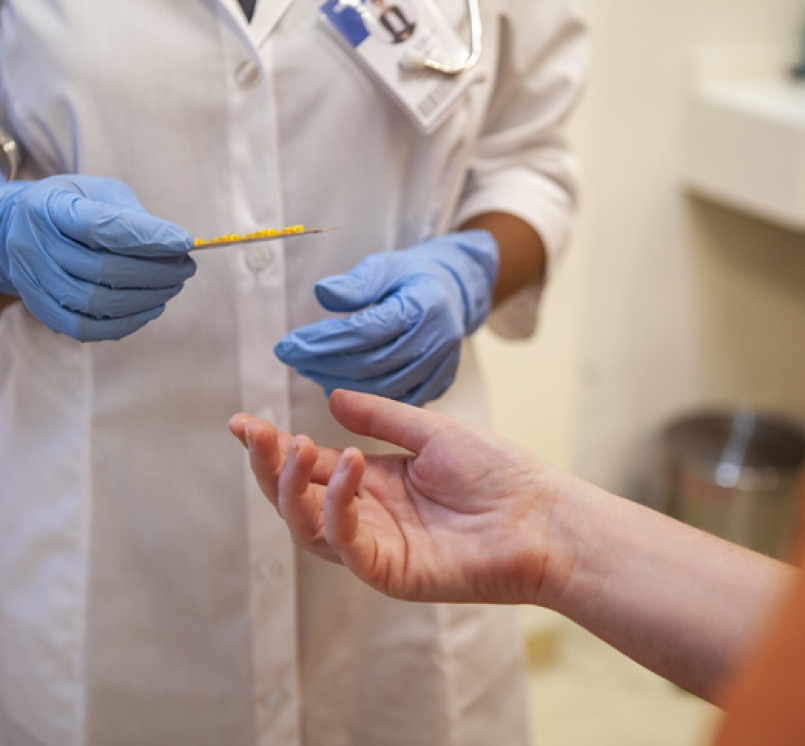Coordination of Care Upon Release From Incarceration: A NACo Opioid Solutions Strategy Brief

Upcoming Events
Related News
“By improving care and coordination prior to release from the justice system, we can help build a bridge back to the community and enhance individual and collective public health and public safety outcomes.”
– Chiquita Brooks-LaSure, Administrator, U.S. Centers for Medicare & Medicaid Services, 2021–20241
What is coordination of care upon release from incarceration?
Overdose is the leading cause of death among formerly incarcerated people,2 particularly within the first two weeks of release.3 With approximately 6 in 10 incarcerated people meeting criteria for substance use disorder,4,5 and more than 600,000 people released from state and federal prisons each year,6 coordination of care is critical to protecting the health and wellbeing of persons returning to the community.
Coordination of care upon release is the deliberate organization and sharing of information between correctional and community-based service providers to ensure the most effective care for each person returning to the community.7 During incarceration, effective care for opioid use disorder (OUD) includes screening and treatment with medications for OUD (MOUD).8,9 Upon release, effective care for individuals with OUD involves linking people to evidence-based care in the community, including:
HEALTH SERVICES
- Assisting with enrollment in Medicaid or other health insurance,
- Connecting with a community-based MOUD provider,
- Ensuring that the costs of treatment and medications are covered and
- Training and equipping all incarcerated persons with naloxone upon release.
Click here to read NACo’s Strategy Brief on effective treatment for opioid use disorder for incarcerated populations.
HUMAN SERVICES
- Providing permanent supportive housing for people with unmet health needs who are at high risk of overdose, homelessness or re-arrest;10
- Engaging peer support specialists to assist individuals with pre-release planning and engagement with health care, social services and the community post-release;11
- Offering temporary guaranteed income, which reduces recidivism and increases the likelihood of finding long-term employment, to formerly incarcerated people living with OUD or at high risk of overdose.12
What evidence supports coordination of care upon release from incarceration?
Treatment with methadone or buprenorphine is an evidence-based overdose prevention strategy13 that reduces the risk of overdose in persons with OUD by as much as 50%.14,15 When Rhode Island began providing universal access to MOUD during incarceration and linkage to community-based treatment with MOUD upon release, the state observed a 60% reduction in mortality among recently incarcerated persons. This is equivalent to one fatal overdose prevented for every 10 persons connected with evidence-based care.16
The FDA has approved three MOUD: buprenorphine, methadone and naltrexone. However, programs that facilitate linkage to treatment solely with naltrexone, and not with methadone or buprenorphine, are in violation of the standards set by the American Society for Addiction Medicine and the National Commission for Correctional Health Care8,9 and may violate the Americans with Disabilities Act.17 Studies have shown that naltrexone is associated with increased risk of overdose among recently incarcerated persons.18,19
Connection with peer-led mutual aid and support programs, including recovery support groups and well-managed recovery housing, are associated with long-term recovery.20–22 Evidence-based peer recovery coaching also increases rates of housing and employment among people living with SUD, including formerly incarcerated people.23 Temporary guaranteed income programs support re-entry across all of these domains by increasing long-term employment, improving mental health and reducing risk taking among recently incarcerated persons.12
Are there risks to my community if we don’t coordinate care for individuals with OUD upon release from incarceration?
Yes.
A key step in coordinating care prior to release from incarceration is securing health care coverage ahead of re-entry. People who do not obtain health care coverage after release have higher rates of recidivism.24
Programs that support treatment and recovery upon release are also cost-effective. Over the course of a lifetime, the total health care and criminal justice cost savings of treatment with MOUD ranges from $40,000 per person (naltrexone) to $100,000 per person (methadone).25 Likewise, formerly incarcerated persons tend to represent greater health care needs and public health care costs due to higher rates of illness and financial precarity than the general population. Without early investment in the recovery and reentry success of formerly incarcerated persons, counties may experience more of these harmful and costly outcomes.
What are best practices for coordinating care for individuals with OUD upon release from incarceration?
- Plan for linkage to care upon release during intake and discharge processes by:
- Completing Medicaid or other health care coverage enrollment procedures26,27
- Scheduling first appointments with community treatment providers, and
- Arranging in-person or telehealth meetings with community treatment providers to initiate this relationship.28
- Work with state and county officials to accelerate the Medicaid enrollment process for formerly incarcerated persons.29 Consider using the Medicaid 1115 wavier to speed-up this processes and/or provide transitional care services.30,31
- Contract with a behavioral health care provider or create a referral network for linkage to MOUD upon release. Seek connections with providers that offer and encourage, but do not mandate, psychotherapy alongside MOUD treatment.28
- Assist formerly incarcerated persons with overcoming practical challenges to employment, such as obtaining a driver’s license, identification card and other documentation of employment eligibility.32
- Consider county-wide “fair chance employment” and “ban the box” initiatives to reduce employment barriers among formerly incarcerated persons. Through these initiatives, counties can encourage employers to hire people who are formerly incarcerated and/or in successful recovery from substance use disorder and protect them from discrimination and exclusion in the job market.33,34
- Hire or partner with peer recovery coaches to provide social support, recovery support and assistance navigating health care and social services to formerly incarcerated people prior to and following release.35
What are some examples of successful coordination of care upon release programs?
Orange County, Calif., has been operating a coordinated care upon reentry program since 2014. The program has been proven to effectively reduce rearrest among persons with mild-to-moderate behavioral health disorders by more than 50%. The program provides intensive case management and linkages to evidence-based treatment, housing services, behavioral health services and community support. Many of these services are offered by community-based providers in direct collaboration with county corrections and health authorities.36
Several jurisdictions, including Stockton, Calif., Durham, N.C., and Alachua County, Fla., have piloted temporary guaranteed income programs that provide unconditional cash payments of $500-600 to formerly incarcerated persons. These programs help persons in finding long-time employment by removing the barriers caused by the financial precarity and uncertainty that many experience after release.12,37,38
In 2013, under a Section 1115 Medicaid waiver, the Cook County, Ill. Department of Corrections began screening incarcerated persons for Medicaid eligibility at intake. The screening process takes about 10 minutes and resulted in more than 10,000 successful Medicaid enrollments in the first two years of implementation.39
Author
Jennifer J. Carroll, PhD, MPH
Dr. Carroll is a medical anthropologist, research scientist and subject matter expert on substance use and public health. She is currently an Assistant Professor of Anthropology at North Carolina State University.
Additional Resources
Best practices for linkage to treatment and services after release
- U.S. Centers for Disease Control and Prevention, “Linking People with Opioid Use Disorder to Medication Treatment: A Technical Package of Policies, Programs, and Practices”
- U.S. Substance Abuse and Mental Health Services Administration, “Continuity of Offender Treatment for Substance Use Disorder From Incarceration to Community”
- Prison Legal News, “A Guide to Finding Housing After Incarceration”
- Office of the Assistant Secretary for Planning and Evaluation, “Strengthening the Social Capital of Incarcerated and Reentering Individuals”
- Office of the Assistant Secretary for Planning and Evaluation, “Peer-to-Peer Supports: Promoting Employment and Well-Being”
Guidance on ways to improve linkage to care through Medicaid
- State Health Access Data Assistance Center, “Targeting Justice-Involved Populations Through 1115 Medicaid Waiver Initiatives: Implementation Experiences of Three States”
- Centers for Medicare and Medicaid Services, “1115 Application Process”
- The Urban Institute, “Using Jail to Enroll Low-Income Men in Medicaid”
- Centers for Medicare and Medicaid Services, “Designing Medicaid Health Homes for Individuals with Opioid Dependency: Considerations for States”
Comprehensive Opioid, Stimulant, and Substance Abuse Program (COSSAP)
COSSAP is a program of the U.S. Bureau of Justice Administration that provides training and technical assistance to COSSAP grantees and to other local, state, and tribal authorities seeking to implement evidence-based responses to substance use within the criminal justice system. COSSAP accepts direct requests for technical assistance and provides such assistance through several partner agencies.
The ORN is a technical assistance collaboration between the American Academy of Addiction Psychiatry and the Addiction Technology Transfer Center at Columbia University. The ORN has local consultants in all 50 states and 9 U.S. territories to provide communities with technical assistance and education on the prevention and treatment of OUD.
Opioid and Stimulant Implementation Support Training and Technical Assistance (OASIS-TTA)
OASIS-TTA, hosted by the University of California, Los Angeles, is on online repository of resources and toolkits for establishing MOUD services in a variety of health and social service settings. OASIS-TTA also accepts direct requests for technical assistance.
Rural Communities Opioid Response Program – Technical Assistance (RCORP-TA)
RCORP-TA is a multi-year initiative by the Health Resources and Services Administration (HRSA) that offers numerous online technical assistance resources related to linkage to care at re-entry.
- Centers for Medicare and Medicaid Services. HHS Releases New Guidance to Encourage States to Apply for New Medicaid Reentry Section 1115 Demonstration Opportunity to Increase Health Care for People Leaving Carceral Facilities. Centers for Medicare & Medicaid Services. Published April 17, 2023. Accessed March 6, 2024. https://www.cms.gov/newsroom/press-releases/hhs-releases-new-guidance-encourage-states-apply-new-medicaid-reentry-section-1115-demonstration
- Binswanger IA, Stern M, Yamashita T, Mueller SR, Baggett TP, Blatchford P. Clinical risk factors for death after release from prison in Washington state: a nested case control study. Addiction. 2016;111(3):499-510.
- Ranapurwala SI, Shanahan ME, Alexandridis AA, et al. Opioid Overdose Mortality Among Former North Carolina Inmates: 2000–2015. Am J Public Health. Published online July 19, 2018:e1-e7. doi:10.2105/AJPH.2018.304514
- Bronson J, Stroop J, Zimmer S, Berzofsky M. Drug Use, Dependence, and Abuse among State Prisoners and Jail Inmates, 2007-2009. Bureau of Justice Statistics, Office of Justice Programs, U.S. Department of Justice; 2017. Accessed December 14, 2018. http://www.bjs.gov/index.cfm?ty=pbdetail&iid=5966
- Sawyer W, Wagner P. Mass Incarceration: The Whole Pie 2022. Prison Policy Initiative. Published March 14, 2022. Accessed September 9, 2022. https://www.prisonpolicy.org/reports/pie2022.html
- Office of the Assistant Secretary for Planning and Evaluation. Incarceration & Reentry. ASPE. Published 2022. Accessed February 4, 2023. https://aspe.hhs.gov/topics/human-services/incarceration-reentry-0
- Agency for Healthcare Research and Quality. Care Coordination. AHRQ. Published 2018. Accessed March 6, 2024. https://www.ahrq.gov/ncepcr/care/coordination.html
- American Society of Addiction Medicine. Public Policy Statement on Treatment of Opioid Use Disorder in Correctional Settings. Published online 2020. Accessed June 8, 2022. https://www.asam.org/docs/default-source/public-policy-statements/2020-statement-on-treatment-of-oud-in-correctional-settings.pdf
- National Commission on Correctional Health Care. Opioid Use Disorder Treatment in Correctional Settings. National Commission on Correctional Health Care. Published 2021. Accessed June 8, 2022. https://www.ncchc.org/opioid-use-disorder-treatment-in-correctional-settings-2021/
- Johnson C. Why Housing Matters for Successful Reentry and Public Safety. PD&R Edge: an online magazin. Published April 19, 2022. Accessed February 4, 2023. https://www.huduser.gov/portal/pdredge/pdr-edge-frm-asst-sec-041922.html
- Hyde J, Byrne T, Petrakis BA, et al. Enhancing community integration after incarceration: findings from a prospective study of an intensive peer support intervention for veterans with an historical comparison group. Health Justice. 2022;10(1):33. doi:10.1186/s40352-022-00195-5
- West S, Castro Baker A, Samra S, Coltrera E. SEED: Stockton Economic Empowerment Demonstration. Published online 2021. Accessed February 4, 2023. https://static1.squarespace.com/static/6039d612b17d055cac14070f/t/603ef1194c474b329f33c329/1614737690661/SEED_Preliminary+Analysis-SEEDs+First+Year_Final+Report_Individual+Pages+-2.pdf
- Carroll JJ, Green TC, Noonan RK. Evidence-Based Strategies for Prevention Opioid Overdose: What’s Working in the United States. Published online 2018. Accessed October 10, 2018. http://www.cdc.gov/drugoverdose/pdf/pubs/2018-evidence-based-strategies.pdf
- National Institutes of Health. Methadone and buprenorphine reduce risk of death after opioid overdose. National Institutes of Health (NIH). Published June 19, 2018. Accessed June 8, 2022. https://www.nih.gov/news-events/news-releases/methadone-buprenorphine-reduce-risk-death-after-opioid-overdose
- Wakeman SE, Larochelle MR, Ameli O, et al. Comparative Effectiveness of Different Treatment Pathways for Opioid Use Disorder. JAMA Network Open. 2020;3(2):e1920622.
- Green TC, Clarke J, Brinkley-Rubinstein L, et al. Postincarceration Fatal Overdoses After Implementing Medications for Addiction Treatment in a Statewide Correctional System. JAMA Psychiatry. 2018;75(4):405-407. doi:10.1001/jamapsychiatry.2017.4614
- Ajazi EM, Dasgupta N, Marshall SW, et al. Revisiting the X: BOT Naltrexone Clinical Trial Using a Comprehensive Survival Analysis. Journal of Addiction Medicine. Published online December 3, 2021. doi:10.1097/ADM.0000000000000931
- Vivitrol and Overdose Risk. Published online February 2022. Accessed June 8, 2022. https://www.evernote.com/shard/s529/sh/7fdef176-3f2f-4684-80b1-6bced0f0168b/17f353618402a37f1bc38b9e5ad63600
- Krueger E, Deal E, Lopez AA, et al. Successful substance use disorder recovery in transitional housing: Perspectives from African American women. Exp Clin Psychopharmacol. 2022;30(5):714-724. doi:10.1037/pha0000527
- Cheney AM, Booth BM, Borders TF, Curran GM. The Role of Social Capital in African Americans’ Attempts to Reduce and Quit Cocaine Use. Subst Use Misuse. 2016;51(6):777-787. doi:10.3109/10826084.2016.1155606
- Jason LA, Salina D, Ram D. Oxford recovery housing: Length of stay correlated with improved outcomes for women previously involved with the criminal justice system. Subst Abus. 2016;37(1):248-254. doi:10.1080/08897077.2015.1037946
- Hansen MA, Modak S, McMaster S, Zoorob R, Gonzalez S. Implementing peer recovery coaching and improving outcomes for substance use disorders in underserved communities. J Ethn Subst Abuse. 2022;21(3):1029-1042. doi:10.1080/15332640.2020.1824839
- Fu JJ, Herme M, Wickersham JA, et al. Understanding the Revolving Door: Individual and Structural-Level Predictors of Recidivism Among Individuals with HIV Leaving Jail. AIDS Behav. 2013;17(0 2):S145-S155. doi:10.1007/s10461-013-0590-1
- Fairley M, Humphreys K, Joyce VR, et al. Cost-effectiveness of Treatments for Opioid Use Disorder. JAMA Psychiatry. 2021;78(7):767-777. doi:10.1001/jamapsychiatry.2021.0247
- Grodensky CA, Rosen DL, Blue CM, et al. Medicaid Enrollment among Prison Inmates in a Non-expansion State: Exploring Predisposing, Enabling, and Need Factors Related to Enrollment Pre-incarceration and Post-Release. J Urban Health. 2018;95(4):454-466. doi:10.1007/s11524-018-0275-1
- Regenstein M, Rosenbaum S. What The Affordable Care Act Means For People With Jail Stays. Health Affairs. 2014;33(3):448-454. doi:10.1377/hlthaff.2013.1119
- Substance Abuse and Mental Health Services Administration. Use of Medication-Assisted Treatment for Opioid Use Disorder in Criminal Justice Settings. Substance Abuse and Mental Health Services Administration (US); 2019. Accessed August 24, 2022. https://store.samhsa.gov/sites/default/files/d7/priv/pep19-matusecjs.pdf
- Patel K, Herdman B, Brown K. Preventing Interruptions in Health Care After Release From Jail. J Correct Health Care. 2022;28(4):215-219. doi:10.1089/jchc.20.12.0119
- Lantsman J. Initiating Medicaid Coverage In Prison 30-Days Prior To Reentry | Health Affairs Forefront. Health Affairs Forefront. Published November 24, 2021. Accessed August 15, 2022. https://www.healthaffairs.org/do/10.1377/forefront.20211123.696972/full/
- Centers for Medicare and Medicaid Services. About Section 1115 Demonstrations. Medicaid.gov. Published 2022. Accessed August 15, 2022. https://www.medicaid.gov/medicaid/section-1115-demonstrations/about-section-1115-demonstrations/index.html
- Grabenstein H. Incarcerated people face barriers to reentry post prison. How one initiative aims to help. PBS NewsHour. Published May 19, 2022. Accessed February 4, 2023. https://www.pbs.org/newshour/nation/incarcerated-people-face-barriers-to-reentry-post-prison-how-one-initiative-aims-to-help
- Johnson L, Ingram V, Fogarty P, Johnson J. Here’s how second-chance hiring can help employers and those in long-term recovery. The Courier-Journal. Published October 8, 2021. Accessed February 4, 2023. https://www.courier-journal.com/story/opinion/2021/10/08/second-chance-hiring-can-help-employers-those-long-term-recovery/5950980001/
- Ban the Box Campaign. About: The Ban the Box Campaign. Ban the Box Campaign. Accessed February 4, 2023. http://bantheboxcampaign.org/about/
- Brown-Graham A, Graham PW, Erickson L, et al. Peer Support as a Social Capital Strategy for Programs Serving Individuals Reentering from Incarceration and Survivors of Intimate Partner Violence or Human Sex Traffcking. Published online 2021. Accessed February 4, 2023. https://www.aspe.hhs.gov/sites/default/files/documents/eacdd84830c8afb60a70554ab7b73875/aspe-social-capital-peer-support-special-topics.pdf?_ga=2.230012697.441224247.1675548678-168981455.1675548678
- Doyle L, Courtney L, Peterson B. Evaluation of Orange County’s Proposition 47 Grant-Related Services (Cohort 2): Interim Evaluation Report. Published online September 2021. Accessed March 11, 2024. https://www.urban.org/sites/default/files/publication/105429/evaluation-of-orange-countys-proposition-47-grant-related-services-cohort-2-interim-evaluation-report.pdf
- Sirdeshmukh G. Durham’s guaranteed income pilot program for the formerly incarcerated sees success in first year, hopes for additional funding. The Chronicle. Published January 26, 2023. Accessed February 4, 2023. https://www.dukechronicle.com/article/2023/01/durham-universal-basic-income-formerly-incarcerated-step-up-durham-excel-pilot-program
- Walters M. Universal basic income eases caregiving after incarceration. Prism. Published January 5, 2023. Accessed February 4, 2023. http://prismreports.org/2023/01/05/universal-basic-income-caregiving-after-incarceration/
- Riedel LE, Barry CL, McGinty EE, et al. Improving Health Care Linkages for Persons: The Cook County Jail Medicaid Enrollment Initiative. J Correct Health Care. 2016;22(3):189-199. doi:10.1177/1078345816653199
Opioid Solutions Center
NACo's Opioid Solutions Center empowers local leaders to invest resources in effective treatment, recovery, prevention and harm reduction practices that save lives and address the underlying causes of substance use disorder.


Effective Treatment for Opioid Use Disorder for Incarcerated Populations: A NACo Opioid Solutions Strategy Brief
Medication-assisted treatment (MAT) is considered the “gold standard” of care for opioid use disorder (OUD). Because incarceration is a known driver of opioid overdose, failure to provide this gold standard of care to incarcerated individuals may exacerbate health risks in your community.

Increasing Access to Evidence-Based Treatment: A NACo Opioid Solutions Strategy Brief
Our health care system’s capacity to provide medications for opioid use disorder (MOUD) falls far below the current demand for care. Only 1 in 4 people who need MOUD are able to access them. A multi-pronged approach is needed to build up the treatment workforce, create effective pathways to care and save lives.

Linkage to Care Across County Systems: A NACo Opioid Solutions Strategy Brief
As the owners and operators of systems of service that regularly interface with people affected by substance use such as hospitals, jails, courts and community colleges, counties are well positioned to link community members with evidence-based options for care, especially medications for opioid use disorder (MOUD).
